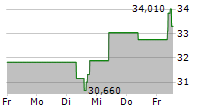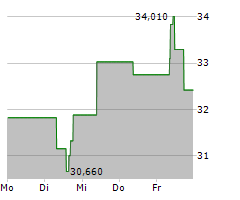- A regulatory decision by the European Medicines Agency is anticipated in 2025 -
- In March 2025, the U.S. Food and Drug Administration approved CABOMETYX in this setting -
Exelixis, Inc. (Nasdaq: EXEL) today announced that its partner Ipsen received a positive opinion from the European Medicine Agency's (EMA) Committee for Medicinal Products for Human Use (CHMP) for CABOMETYX (cabozantinib) for adult patients with unresectable or metastatic, well-differentiated extra-pancreatic (epNET) and pancreatic (pNET) neuroendocrine tumors who have progressed following at least one prior systemic therapy other than somatostatin analogues. The European Commission (EC), which has the authority to approve medicines for the European Union (EU), will now review the CHMP recommendation, and a final decision on the application is expected in the coming months.
"Neuroendocrine tumors are difficult to treat given their indolent nature and lack of robust responses to traditional oncology agents. This often results in people living with this type of cancer for long periods of time and running out of effective options, underscoring the critical need for new treatments following disease progression," said Amy Peterson, M.D., Executive Vice President, Product Development and Medical Affairs, and Chief Medical Officer. "The CHMP's recommendation is a pivotal milestone for our partner Ipsen as they work to bring CABOMETYX to patients in Europe, and we look forward to hearing the European Commission's decision in the coming months."
The CHMP recommendation is based on results from the phase 3 CABINET pivotal trial, which is evaluating CABOMETYX compared with placebo in two cohorts of patients with previously treated NET: advanced pNET and advanced epNET. CABINET was the basis for the U.S. Food and Drug Administration (FDA) approval of CABOMETYX in March 2025 for the treatment of 1) adult and pediatric patients 12 years of age and older with previously treated, unresectable, locally advanced or metastatic, well-differentiated pNET; and 2) adult and pediatric patients 12 years of age and older with previously treated, unresectable, locally advanced or metastatic, well-differentiated epNET. Final progression-free survival (PFS) results were presented at the 2024 European Society for Medical Oncology Congress and published in The New England Journal of Medicine
About CABINET (Alliance A021602)
CABINET (Randomized, Double-Blinded, Phase III Study of CABozantinib versus Placebo In Patients with Advanced NEuroendocrine Tumors After Progression on Prior Therapy) is sponsored by the National Cancer Institute (NCI), part of the National Institutes of Health, and is being led and conducted by the NCI-funded Alliance for Clinical Trials in Oncology with participation from the NCI-funded National Clinical Trials Network, as part of Exelixis' collaboration through a Cooperative Research and Development Agreement with the NCI's Cancer Therapy Evaluation Program.
CABINET is a multicenter, randomized, double-blinded, placebo-controlled phase 3 pivotal trial that enrolled a total of 298 patients in two separate cohorts (pNET and epNET) in the U.S. at the time of the final analysis. Patients were randomized 2:1 to cabozantinib (60 mg) or placebo; each cohort was randomized separately and had its own statistical analysis plan. The trial was stopped early after an interim analysis showed superior efficacy associated with cabozantinib as compared to placebo in each of the two cohorts. Patients with epNET had primary tumors arising in the gastrointestinal (GI) tract, lung, unknown primary sites and other organs. Patients must have had measurable disease per RECIST 1.1 criteria and must have experienced disease progression or intolerance after at least one U.S. FDA-approved line of prior systemic therapy other than somatostatin analogs. The primary endpoint in each cohort was PFS per RECIST 1.1 by blinded independent central review. Secondary endpoints included overall survival, objective response rate and safety. More information about this trial is available at ClinicalTrials.gov.
About NET
NET are cancers that begin in the specialized cells of the body's neuroendocrine system.1 These cells have traits of both hormone-producing endocrine cells and nerve cells.1 It is estimated that 161,000 to 192,000 people in the U.S. are living with unresectable, locally advanced or metastatic NET.2 The number of people diagnosed with NET has been increasing in recent decades.3 Functional NET release peptide hormones that can cause debilitating symptoms, like diarrhea, hypertension and flushing, while symptoms of non-functional NET are related primarily to tumor growth.4,5,6,7,8 Most NET take years to develop and grow slowly, but eventually all patients with advanced or metastatic NET will develop refractory and progressing disease.9,10
NET can start in the pancreas (pNET), where they tend to be more aggressive, with a five-year survival rate of only 23% for advanced disease.1,11 NET can also develop in any part of the body, but most commonly start in the GI tract or in the lungs, where they have historically been referred to as carcinoid tumors and are more recently called epNET.1 The five-year survival rates for advanced GI and lung NET tumors are 68% and 55%, respectively.12,13 For advanced NET patients, treatment options include somatostatin analogs, chemotherapy, molecular targeted therapy and peptide-receptor radionuclide therapy.14
About CABOMETYX (cabozantinib)
In the U.S., CABOMETYX tablets are approved as monotherapy for the treatment of patients with advanced renal cell carcinoma (RCC) and in combination with nivolumab as a first-line treatment for patients with advanced RCC; for the treatment of patients with hepatocellular carcinoma (HCC) who have been previously treated with sorafenib; for adult and pediatric patients 12 years of age and older with locally advanced or metastatic differentiated thyroid cancer (DTC) that has progressed following prior VEGFR-targeted therapy and who are radioactive iodine-refractory or ineligible; for the treatment of adult and pediatric patients 12 years of age and older with previously treated, unresectable, locally advanced or metastatic, well-differentiated pNET; and adult and pediatric patients 12 years of age and older with previously treated, unresectable, locally advanced or metastatic, well-differentiated epNET. CABOMETYX tablets have also received regulatory approvals in over 65 countries outside the U.S. and Japan, including the EU. In 2016, Exelixis granted Ipsen Pharma SAS exclusive rights for the commercialization and further clinical development of cabozantinib outside of the U.S. and Japan. In 2017, Exelixis granted exclusive rights to Takeda Pharmaceutical Company Limited for the commercialization and further clinical development of cabozantinib for all future indications in Japan. Exelixis holds the exclusive rights to develop and commercialize cabozantinib in the U.S.
IMPORTANT SAFETY INFORMATION
WARNINGS AND PRECAUTIONS
Hemorrhage: CABOMETYX can cause severe and fatal hemorrhages. The incidence of Grade 3-5 hemorrhagic events was 5% in CABOMETYX patients in RCC, HCC, and DTC studies. Discontinue CABOMETYX for Grade 3-4 hemorrhage and before surgery. Do not administer to patients who have a recent history of hemorrhage, including hemoptysis, hematemesis, or melena.
Perforations and Fistulas: Fistulas, including fatal cases, and gastrointestinal (GI) perforations, including fatal cases, each occurred in 1% of CABOMETYX patients. Monitor for signs and symptoms, and discontinue CABOMETYX in patients with Grade 4 fistulas or GI perforation.
Thrombotic Events: CABOMETYX can cause arterial or venous thromboembolic event. Venous thromboembolism occurred in 7% (including 4% pulmonary embolism) and arterial thromboembolism in 2% of CABOMETYX patients. Fatal thrombotic events have occurred. Discontinue CABOMETYX in patients who develop an acute myocardial infarction or serious arterial or venous thromboembolic events.
Hypertension and Hypertensive Crisis: CABOMETYX can cause hypertension, including hypertensive crisis. Hypertension was reported in 37% (16% Grade 3 and <1% Grade 4) of CABOMETYX patients. In CABINET (n=195), hypertension occurred in 65% (26% Grade 3) of CABOMETYX patients. Do not initiate CABOMETYX in patients with uncontrolled hypertension. Monitor blood pressure regularly during CABOMETYX treatment. Withhold CABOMETYX for hypertension that is not adequately controlled; when controlled, resume at a reduced dose. Permanently discontinue CABOMETYX for severe hypertension that cannot be controlled with antihypertensive therapy or for hypertensive crisis.
Diarrhea: CABOMETYX can cause diarrhea and it occurred in 62% (10% Grade 3) of treated patients. Monitor and manage patients using antidiarrheals as indicated. Withhold CABOMETYX until improvement to Grade 1; resume at a reduced dose.
Palmar-Plantar Erythrodysesthesia (PPE): CABOMETYX can cause PPE and it occurred in 45% of treated patients (13% Grade 3). Withhold CABOMETYX until PPE resolves or decreases to Grade 1 and resume at a reduced dose for intolerable Grade 2 PPE or Grade 3 PPE.
Hepatotoxicity: CABOMETYX in combination with nivolumab in RCC can cause hepatic toxicity with higher frequencies of Grades 3 and 4 ALT and AST elevations compared to CABOMETYX alone. With the combination of CABOMETYX and nivolumab, Grades 3 and 4 increased ALT or AST were seen in 11% of patients. Monitor liver enzymes before initiation of treatment and periodically. Consider more frequent monitoring as compared to when the drugs are administered as single agents. Consider withholding CABOMETYX and/or nivolumab, initiating corticosteroid therapy, and/or permanently discontinuing the combination for severe or life-threatening hepatotoxicity.
Adrenal Insufficiency: CABOMETYX in combination with nivolumab can cause primary or secondary adrenal insufficiency. Adrenal insufficiency occurred in 4.7% (15/320) of patients with RCC who received CABOMETYX with nivolumab, including Grade 3 (2.2%), and Grade 2 (1.9%) adverse reactions. Withhold CABOMETYX and/or nivolumab and resume CABOMETYX at a reduced dose depending on severity.
Proteinuria: Proteinuria was observed in 8% of CABOMETYX patients. Monitor urine protein regularly during CABOMETYX treatment. For Grade 2 or 3 proteinuria, withhold CABOMETYX until improvement to Grade 1 proteinuria; resume CABOMETYX at a reduced dose. Discontinue CABOMETYX in patients who develop nephrotic syndrome.
Osteonecrosis of the Jaw (ONJ): CABOMETYX can cause ONJ and it occurred in <1% of treated patients. Perform an oral examination prior to CABOMETYX initiation and periodically during treatment. Advise patients regarding good oral hygiene practices. Withhold CABOMETYX for at least 3 weeks prior to scheduled dental surgery or invasive dental procedures. Withhold CABOMETYX for development of ONJ until complete resolution; resume at a reduced dose.
Impaired Wound Healing: CABOMETYX can cause impaired wound healing. Withhold CABOMETYX for at least 3 weeks prior to elective surgery. Do not administer for at least 2 weeks after major surgery and until adequate wound healing. The safety of resumption of CABOMETYX after resolution of wound healing complications has not been established.
Reversible Posterior Leukoencephalopathy Syndrome (RPLS): CABOMETYX can cause RPLS. Perform evaluation for RPLS and diagnose by characteristic finding on MRI any patient presenting with seizures, headache, visual disturbances, confusion, or altered mental function. Discontinue CABOMETYX in patients who develop RPLS.
Thyroid Dysfunction: CABOMETYX can cause thyroid dysfunction, primarily hypothyroidism, and it occurred in 19% of treated patients (0.4% Grade 3). Assess for signs of thyroid dysfunction prior to the initiation of CABOMETYX and monitor for signs and symptoms during treatment.
Hypocalcemia: CABOMETYX can cause hypocalcemia, with the highest incidence in DTC patients. Based on the safety population, hypocalcemia occurred in 13% of CABOMETYX patients (2% Grade 3 and 1% Grade 4).
Monitor blood calcium levels and replace calcium as necessary during treatment. Withhold and resume CABOMETYX at a reduced dose upon recovery or permanently discontinue CABOMETYX depending on severity.
Embryo-Fetal Toxicity: CABOMETYX can cause fetal harm. Advise pregnant women of the potential risk to a fetus and advise females of reproductive potential to use effective contraception during treatment with CABOMETYX and for 4 months after the last dose.
ADVERSE REACTIONS
The most common (=20%) adverse reactions are:
CABOMETYX as a single agent: diarrhea, fatigue, PPE, decreased appetite, hypertension, nausea, vomiting, weight decreased, and constipation.
CABOMETYX in combination with nivolumab: diarrhea, fatigue, hepatotoxicity, PPE, stomatitis, rash, hypertension, hypothyroidism, musculoskeletal pain, decreased appetite, nausea, dysgeusia, abdominal pain, cough, and upper respiratory tract infection.
DRUG INTERACTIONS
Strong CYP3A4 Inhibitors: If coadministration with strong CYP3A4 inhibitors cannot be avoided, reduce the CABOMETYX dosage. Avoid grapefruit or grapefruit juice.
Strong or Moderate CYP3A4 Inducers: If coadministration with strong or moderate CYP3A4 inducers cannot be avoided, increase the CABOMETYX dosage. Avoid St. John's wort.
USE IN SPECIFIC POPULATIONS
Lactation: Advise women not to breastfeed during CABOMETYX treatment and for 4 months after the final dose.
Hepatic Impairment: In patients with moderate hepatic impairment, reduce the CABOMETYX dosage. Avoid CABOMETYX in patients with severe hepatic impairment.
Pediatric Use: Physeal widening has been observed in children with open growth plates when treated with CABOMETYX. Physeal and longitudinal growth monitoring is recommended in children (12 years and older) with open growth plates. Consider interrupting or discontinuing CABOMETYX if abnormalities occur. The safety and effectiveness of CABOMETYX in pediatric patients less than 12 years of age have not been established.
Please see accompanying full Prescribing Information
https://www.cabometyx.com/downloads/CABOMETYXUSPI.pdf
You are encouraged to report negative side effects of prescription drugs to the FDA. Visit www.FDA.gov/medwatch or call 1-800-FDA-1088.
About Exelixis
Exelixis is a globally ambitious oncology company innovating next-generation medicines and regimens at the forefront of cancer care. Powered by drug discovery and development excellence, we are rapidly evolving our product portfolio to target an expanding range of tumor types and indications with our clinically differentiated pipeline of small molecules, antibody-drug conjugates and other biotherapeutics. This comprehensive approach harnesses decades of robust investment in our science and partnerships to advance our investigational programs and extend the impact of our flagship commercial product, CABOMETYX (cabozantinib). Exelixis is driven by a bold scientific pursuit to create transformational treatments that give more patients hope for the future. For information about the company and its mission to help cancer patients recover stronger and live longer, visit www.exelixis.com, follow @ExelixisInc on X (Twitter), like Exelixis, Inc. on Facebook and follow Exelixis on LinkedIn.
Forward-Looking Statements
This press release contains forward-looking statements, including, without limitation, statements related to: the therapeutic potential of CABOMETYX for patients with previously treated advanced neuroendocrine tumors; the regulatory review process in the EU, including the expected timing for a final decision from the EC; Exelixis' or its partner Ipsen's ability or plans to support these new indications for patients in Europe; and Exelixis' scientific pursuit to create transformational treatments that give more patients hope for the future. Any statements that refer to expectations, projections or other characterizations of future events or circumstances are forward-looking statements and are based upon Exelixis' current plans, assumptions, beliefs, expectations, estimates and projections. Forward-looking statements involve risks and uncertainties. Actual results and the timing of events could differ materially from those anticipated in the forward-looking statements as a result of these risks and uncertainties, which include, without limitation: complexities and the unpredictability of the regulatory review and approval processes in the EU and elsewhere, including the risk that the EC may not approve CABOMETYX for the treatment of adult patients with unresectable or metastatic, well-differentiated epNET and pNET who have progressed following at least one prior systemic therapy other than a somatostatin analogue in a timely fashion, if at all; unexpected concerns that may arise as a result of the occurrence of adverse safety events or additional data analyses of clinical trials evaluating cabozantinib; Exelixis' dependence on its relationships with its collaboration partners, including their pursuit of regulatory approvals for partnered compounds in new indications and their adherence to their obligations under relevant collaboration agreements; Exelixis' ability to protect its intellectual property rights; market competition, including the potential for competitors to obtain approval for generic versions of CABOMETYX; changes in economic and business conditions; and other factors affecting Exelixis and its partners to obtain regulatory approval for cabozantinib in new indications; and other factors detailed from time to time under the caption "Risk Factors" in Exelixis' most recent Annual Report on Form 10-K and subsequent Quarterly Reports on Form 10-Q, and in Exelixis' other future filings with the Securities and Exchange Commission. All forward-looking statements in this press release are based on information available to Exelixis as of the date of this press release, and Exelixis undertakes no obligation to update or revise any forward-looking statements contained herein, except as required by law.
Exelixis, the Exelixis logo and CABOMETYX are registered U.S. trademarks of Exelixis.
____________________ 1 Neuroendocrine Tumors. Cleveland Clinic website. Available at: https://my.clevelandclinic.org/health/diseases/22006-neuroendocrine-tumors-net. Accessed June 2025. 2 Population Estimate: Unresectable, Locally Advanced or Metastatic Extra-Pancreatic NET. June 2024 (internal data on file). 3 Pathak, S., Starr, J.S., Halfdanarson T., et al. Understanding the increasing incidence of neuroendocrine tumors. Expert Rev Endocrinol Metab. September 2023;18(5):377-385. 4 Pancreatic Neuroendocrine Tumors (Islet Cell Tumors) Treatment (PDQ)-Patient Version. NCI website. Available at: https://www.cancer.gov/types/pancreatic/patient/pnet-treatment-pdq. Accessed June 2025. 5 What Is a Pancreatic Neuroendocrine Tumor? ACS website. Available at: https://www.cancer.org/cancer/types/pancreatic-neuroendocrine-tumor/about/what-is-pnet.html. Accessed June 2025. 6 Carcinoid Syndrome. Cleveland Clinic website. Available at: https://my.clevelandclinic.org/health/diseases/22103-carcinoid-syndrome. Accessed June 2025. 7 Signs and Symptoms of Gastrointestinal Carcinoid Tumors. ACS website. Available at: https://www.cancer.org/cancer/types/gastrointestinal-carcinoid-tumor/detection-diagnosis-staging/signs-symptoms.html. Accessed June 2025. 8 Signs and Symptoms of Lung Carcinoid Tumors. ACS website. Available at: https://www.cancer.org/cancer/types/lung-carcinoid-tumor/detection-diagnosis-staging/signs-and-symptoms.html. Accessed June 2025. 9 McClellan, K., Chen. E.Y, Kardosh A., et al. Therapy Resistant Gastroenteropancreatic Neuroendocrine Tumors. Cancers. 2022;14(19):4769. 10 What is a Gastrointestinal Carcinoid Tumor? ACS website. Available at: https://www.cancer.org/cancer/types/gastrointestinal-carcinoid-tumor/about/what-is-gastrointestinal-carcinoid.html. Accessed June 2025. 11 Survival Rates for Pancreatic Neuroendocrine Tumor. ACS website. Available at: https://www.cancer.org/cancer/types/pancreatic-neuroendocrine-tumor/detection-diagnosis-staging/survival-rates.html. Accessed June 2025. 12 Survival Rates for Gastrointestinal Carcinoid Tumors. ACS website. Available at: https://www.cancer.org/cancer/types/gastrointestinal-carcinoid-tumor/detection-diagnosis-staging/survival-rates.html. Accessed June 2025. 13 Survival Rates for Lung Carcinoid Tumors. ACS website. Available at: https://www.cancer.org/cancer/types/lung-carcinoid-tumor/detection-diagnosis-staging/survival-rates.html. Accessed June 2025. 14 Neuroendocrine Tumor (NET). NCI website. Available at: https://www.cancer.gov/pediatric-adult-rare-tumor/rare-tumors/rare-endocrine-tumor/carcinoid-tumor. Accessed June 2025. |
View source version on businesswire.com: https://www.businesswire.com/news/home/20250619250880/en/
Contacts:
Investors Contact:
Susan Hubbard
EVP, Public Affairs and Investor Relations
Exelixis, Inc.
(650) 837-8194
shubbard@exelixis.com
Media Contact:
Claire McConnaughey
Senior Director, Public Affairs
Exelixis, Inc.
(650) 837-7052
cmcconn@exelixis.com




